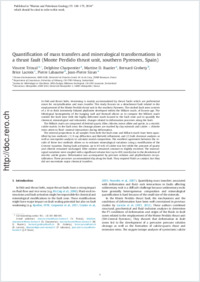Quantification of mass transfers and mineralogical transformations in a thrust fault (Monte Perdido thrust unit, southern Pyrenees, Spain)
- Trincal, Vincent Chrono-Environnement, UMR 6249, Université de Franche-Comté, Besançon, France
- Charpentier, Delphine Chrono-Environnement, UMR 6249, Université de Franche-Comté, Besançon, France
- Buatier, Martine D. Chrono-Environnement, UMR 6249, Université de Franche-Comté, Besançon, France
- Grobéty, Bernard Department of Geosciences, University of Fribourg, Switzerland
- Lacroix, Brice Institut de Minéralogie et Géochimie, Université de Lausanne, Switzerland
- Labaume, Pierre Géosciences Montpellier, UMR 5243, Université Montpellier 2, France
- Sizun, Jean-Pierre Chrono-Environnement, UMR 6249, Université de Franche-Comté, Besançon, France
-
31.12.2013
Published in:
- Marine and Petroleum Geology. - 2014, vol. 55, p. 160-175
English
In fold-and-thrust belts, shortening is mainly accommodated by thrust faults which are preferential zones for recrystallisation and mass transfer. This study focuses on a detachment fault related to the emplacement of the Monte Perdido thrust unit in the southern Pyrenees. The studied fault zone consists of a 10 m thick intensively foliated phyllonite developed within the Millaris marls, of Eocene age. The lithological homogeneity of the hanging wall and footwall allows us to compare the Millaris marls outside the fault zone with the highly deformed marls located in the fault zone and to quantify the chemical, mineralogical and volumetric changes related to deformation processes along the fault. The Millaris marls are composed of detrital quartz, illite, chlorite, minor albite and pyrite, in a micritic calcite matrix. In the fault zone, the cleavage planes are marked by clay minerals and calcite ± chlorite veins attest to fluid–mineral interactions during deformation. The mineral proportions in all samples from both the fault zone and Millaris marls have been quantified by two methods: (1) X-ray diffraction and Rietveld refinement, and (2) bulk chemical analyses as well as microprobe analyses to calculate modal composition. The excellent agreement between the results of these two methods allows us to estimate mineralogical variations using a modification of the Gresens' equation. During fault activation, up to 45 wt% of calcite was lost while the amounts of quartz and chlorite remained unchanged. Illite content remained constant to slightly enriched. The mineralogical variations were coupled with a significant volume loss (up to 45%) mostly due to the dissolution of micritic calcite grains. Deformation was accompanied by pressure solution and phyllosilicates recrystallisation. These processes accommodated slip along the fault. They required fluids as catalyst, but they did not necessitate major chemical transfers.
- Faculty
- Faculté des sciences et de médecine
- Department
- Département de Géosciences
- Language
-
- English
- Classification
- Geology
- License
- License undefined
- Identifiers
-
- RERO DOC 211418
- DOI 10.1016/j.marpetgeo.2013.12.016
- Persistent URL
- https://folia.unifr.ch/unifr/documents/303678
Statistics
Document views: 77
File downloads:
- gro_qmt.pdf: 268
